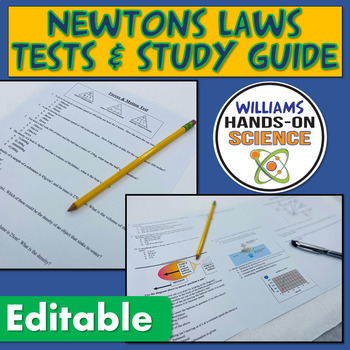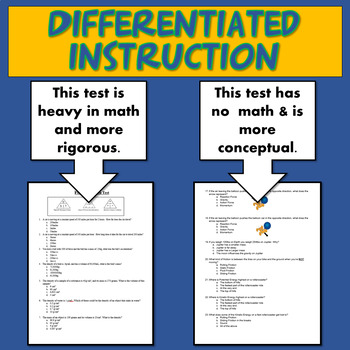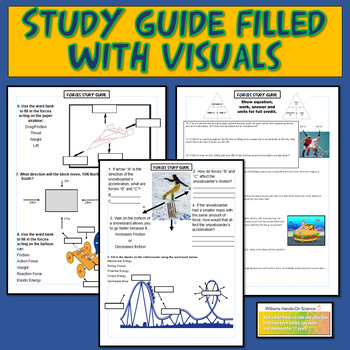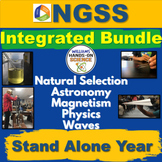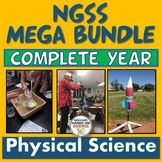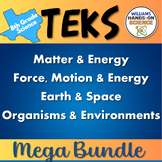Newton's Laws of Motion Test Study Guide NGSS PS2.A Test Prep Digital
- Zip
Also included in
- Your students will remember these activities forever! These are student centered, challenging, hands-on, engaging activities that will wow and motivate even some of the most reluctant learners. I also include an editable unit test and a modified Special Education/English Language Learner test. I’vePrice $59.97Original Price $88.75Save $28.78
- Looking for a complete, standalone year-long curriculum for integrated NGSS Physics, Energy, Waves, Astronomy, Earth’s History, Science and Engineering Practices, Crosscutting Concepts, and Evolution? Look no further than this student-centered, inquiry-based, hands-on bundle! Designed to align withPrice $205.00Original Price $366.00Save $161.00
- This bundle is a time-saving, comprehensive and user-friendly complete year bundle for physical science Teachers that will streamline your teaching experience effortlessly! Every lesson is meticulously planned and just a click away. This extraordinary bundle is a treasure trove of engaging resourcesPrice $176.00Original Price $311.50Save $135.50
- The TEKS 8th Grade Bundle is a comprehensive resource for teaching science mainly in Texas, but it can be used in any state. This bundle includes over 60 hands-on, rigorous, engaging, and phenomena-driven lessons that cover the TEKS standards for 8th grade science. The lessons are designed to help sPrice $160.00Original Price $321.15Save $161.15
Description
These two tests and study guide are conceptual and have real-life applications to Newton's 3 Laws of Motion. They include True-False, multiple choice, short answer and are editable. Pictures/visuals are included for all styles of learning.
With the two different tests you have multiple options!
Option 1: Choose the test that would be most appropriate for your students.
Option 2: Use one test as a review and one test as the summative assessment.
Option 3: Give some students one test and the rest of the students the other test based on ability level.
The study guide contains visuals that put Newton’s laws into real-life context!
This product includes the following:
-One editable 24 question test and key
-One editable 30 question test and key
-Study Guide and key
This product includes the following concepts:
-Newton’s 1st Law
-Newton’s 2nd Law
-Newton’s 3rd Law
-Balanced Forces
-Unbalanced Forces
-Speed/Velocity
-Kinetic Energy
-Potential Energy
-Mechanical Energy
-Elastic Energy
-Friction
-Rolling Friction
-Sliding Friction
-Static Friction
-Fluid Friction/Drag
-Centripetal Force
-Gravity/Weight
-Density/Buoyancy
NGSS Standards:
PS2.A: Forces and Motion
• For any pair of interacting objects, the force exerted by the first object on the second object is equal in strength to the force that the second object exerts on the first, but in the opposite direction (Newton’s third law). (MS-PS2-1)
• The motion of an object is determined by the sum of the forces acting on it; if the total force on the object is not zero, its motion will change. The greater the mass of the object, the greater the force needed to achieve the same change in motion. For any given object, a larger force causes a larger change in motion. (MS-PS2-2)
• All positions of objects and the directions of forces and motions must be described in an arbitrarily chosen reference frame and arbitrarily chosen units of size. In order to share information with other people, these choices must also be shared. (MS-PS2-2)
PS2.B: Types of Interactions
• Forces that act at a distance (electric, magnetic, and gravitational) can be explained by fields that extend through space and can be mapped by their effect on a test object (a charged object, or a ball, respectively). (MS-PS2-5)
• Gravitational forces are always attractive. There is a gravitational force between any two masses, but it is very small except when one or both of the objects have large mass—e.g., Earth and the sun. (MS-PS2-4)
PS3.A: Definitions of Energy
• Motion energy is properly called kinetic energy (MS-PS3-1)
• A system of objects may also contain stored (potential) energy, depending on their relative positions. (MS-PS3-2)
PS3.B: Conservation of Energy and Energy Transfer
• When the motion energy of an object changes, there is inevitably some other change in energy at the same time. (MS-PS3-5)
PS3.C: Relationship Between Energy and Forces
• When two objects interact, each one exerts a force on the other that can cause energy to be transferred to or from the object. (MS-PS3-2)
Thank you for taking a look!
Please follow me on TpT for new products and check me out on Instagram to see my products in action!
https://www.instagram.com/williamshandsonscience/
Take a look at my bundles
Physical Science Growing Bundle
Related Physics Products
⭐ 10 Editable Motion Bell Ringer Warm Ups and Key
⭐ 5E NGSS Collision Lab: Relationship between Motion and Forces
⭐ Balloon Rockets Lab
⭐ Bell Ringer Warm Up: Force, Acceleration, Graphing & Energy
⭐ Bell Ringer Warm Up: Force, Acceleration, Graphing & Energy
⭐ Bell Ringer Warm Up: Speed, Acceleration & Graphing
⭐ Bell Ringer Warm Up: Speed, Acceleration & Graphing
⭐ Bell Ringer Warm Up: Speed, Acceleration & Graphing
⭐ FORCES: 50 Editable PowerPoint Slides with Hyperlinks
⭐ Forces Warm Up
⭐ Middle School Physics Motion PowerPoint, Guided Notes, Study Guide & Test
⭐ Middle School Physics Bell Ringers (Warm Ups)
⭐ NGSS Flipping the Classroom with Frayer Forces and Interactions
⭐ NGSS Kinetic and Potential Energy Card sort, Energy Worksheet & Close Reading
⭐ NGSS Middle School Chemistry Bundle
⭐ NGSS Middle School Physics Bundle & ASSESSMENT
⭐ NGSS Newton's Laws Card Sort & 50 Slide PowerPoint
⭐ NGSS Physics Speed, Time and Distance Math Problems
⭐ NGSS STEM 5E Paper Airplane Competition Engineering Design Process
⭐ NGSS Special Education & ELL Graphing Motion Worksheets
⭐ NGSS Speed, Time, Distance, Acceleration and Graphing Worksheets
⭐ Netwon's Laws Drawing Review: Winter Holidays
⭐ Newton's Laws Physics Problems
⭐ Newton's Laws Test and Study Guide (Editable)
⭐ PhET Simulation: Moving Man Graphing Motion Online Lab
⭐ Physics Online Computer Simulation Lab
⭐ Roller Coaster Energy Warm Up
⭐ STEM 5E NGSS Aligned Balloon Cars Lab Engineering Design Process
⭐ STEM Bottle Rockets Lab PowerPoint Graphic Organizers Close Reading Cloze Notes
⭐ STEM NGSS Middle School Science Growing MEGA Bundle
⭐ STEM NGSS Physics Resource Bundle
⭐ STEM Roller Coaster Lab & Card Sort Engineering Design Process

